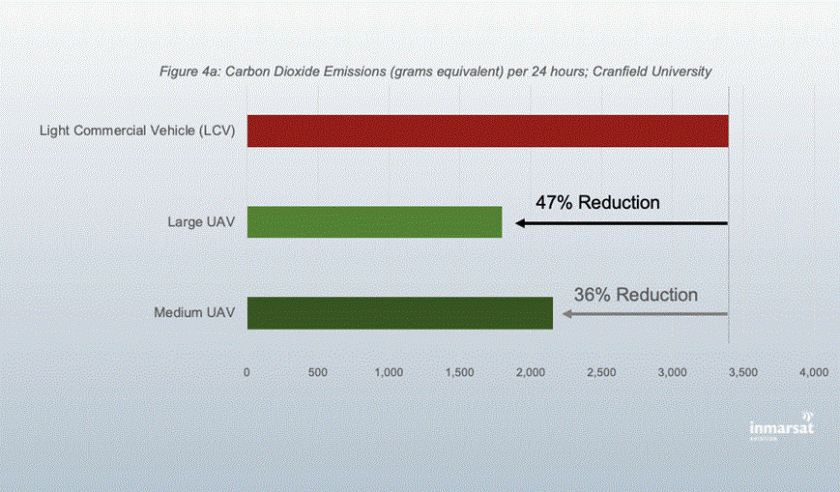As part of the report, ‘UAVs: Unlocking positive transformation in the world’, Cranfield University has used its own modelling and primary data resources to compare the CO2 emissions omitted by unmanned ariel vehicles (UAVs) and small light commercial vehicles (LCVs). The results found a significant reduction in CO2 emissions produced when using UAVs for freight delivery, critical as sustainability becomes even more of a key business priority.
| Mode of transport | Route / size of delivery | CO2 emissions produced |
| LCV | Delivering 10 similar sized packages per 8-hour shift over a 5km delivery radius, and following a regular schedule of consecutive deliveries | 3,394 grams per 24 hours (3 shifts) |
| Large-sized UAV | 50kg payload operating in the same delivery protocol as the LCV | 1,800 grams of emissions per 24 hours, a 47% reduction |
| Medium-sized UAV | 36km range, carrying a 5kg payload under less-than-optimal operating pattern (making separate individual journeys from the central warehouse rather than making consecutive deliveries) | 2,1600 grams of carbon dioxide emissions over 24 hours, a 36% reduction |
The report, which analyses both new and existing research, also examined the wealth of new possibilities and applications unlocked by commercial UAVs, including across the healthcare and medical and agriculture industries.
An LCV delivering 10 similar sized packages per 8-hour shift over a 5km delivery radius, and following a regular schedule of consecutive deliveries, produces an estimated CO2 emission rate of 3,394 grams per 24 hours (3 shifts), say the researchers. In contrast, a large-sized UAV with a 50kg payload operating in the same delivery protocol as the LCV produces 1,800 grams of emissions per 24 hours, a 47% reduction.
“Alternatively, a medium-sized UAV with a 36km range, carrying a 5kg payload under less-than-optimal operating pattern (making separate individual journeys from the central warehouse rather than making consecutive deliveries) was estimated to produce 2,160 grams of carbon dioxide emissions over 24 hours – a significant reduction of 36% compared to the equivalent LCV road transport.”
The report, which analyses both new and existing research, also identifies the many other commercial advantages provided by UAVs to organisations that embrace the technology and adopt new operational methods, with cost and time savings leading to enhanced supply chain and business efficiencies. In addition, it explores the considerable benefits that extend beyond those driven by commercial gain, such as delivering humanitarian and medical aid to remote communities and conflict zones, surveillance to protect endangered animals from poachers and monitoring for illegal deforestation or mining operations.
Professor Dame Helen Atkinson DBE FREng, Cranfield University’s Pro-Vice-Chancellor of the School of Aerospace, Transport and Manufacturing, said: “Commercial UAVs have the potential to transform our world in a range of safe and environmentally friendly ways. This report is an important step in harnessing the power of UAVs and unlocking the opportunities they offer to advance air transport activities and services with fast and efficient delivery of goods.”
Anthony Spouncer, Inmarsat’s Senior Director of UAVs and Unmanned Traffic Management (UTM), said: “It’s also clear that unless autonomous vehicles and unmanned aviation are safely and securely integrated into managed airspace, their true potential cannot be unlocked on a commercial scale.
Inmarsat and Cranfield University’s report, ‘UAVs: Unlocking positive transformation in the world’, is available to download here.




